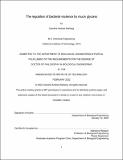| dc.description.abstract | Mucus is a major ecological niche for the microbiota, forming a habitat in which beneficial microbes can thrive while preventing outgrowth and infection of potentially pathogenic microbes. The virulence-disruption activity of mucus is enabled mucin, a glycoprotein that forms the mucus gel. Upon sensing the O-glycans displayed mucin, opportunistic pathogens can alter their gene expression, and are less likely to engage in virulence behaviors like biofilm formation and toxin production. Therefore, mucin gels can be considered a sophisticated bioactive material with the ability to manipulate microbial behavior and phenotypes, select for beneficial organisms, and protect host epithelial surfaces. These properties motivate the creation of mucin-inspired materials that can reproduce the protective effects of mucin in patients with mucosal disorders or infections.
This thesis reports the production of bioactive mucin-inspired materials that can disarm the virulence of pathogenic bacteria. As a model system, we looked at the oral cavity, where salivary mucus prevents the opportunistic pathogen Streptococcus mutans from causing cavities. First, we identified that mucin glycans were the structural components of mucus that were essential for preventing biofilm formation, quorum sensing, toxin production, and genetic competence. Next, we leveraged this knowledge to create glycan-bearing materials that selectively prevent Streptococcus mutans biofilm formation. Finally, we reproduce this workflow in a second niche, where we identify glycans that can prevent biofilm formation and epithelial cell killing by the vaginal pathogen Gardnerella vaginalis. Together, these results present a roadmap for the development of mucin-inspired antivirulence materials for various niches. With the rise of clinical antimicrobial resistance, these materials, which treat infections by hijacking nutrient sensing pathways rather than directly killing bacteria, present a novel strategy for treating infections that can target pathogens while leaving the commensal microbiome intact. | |
